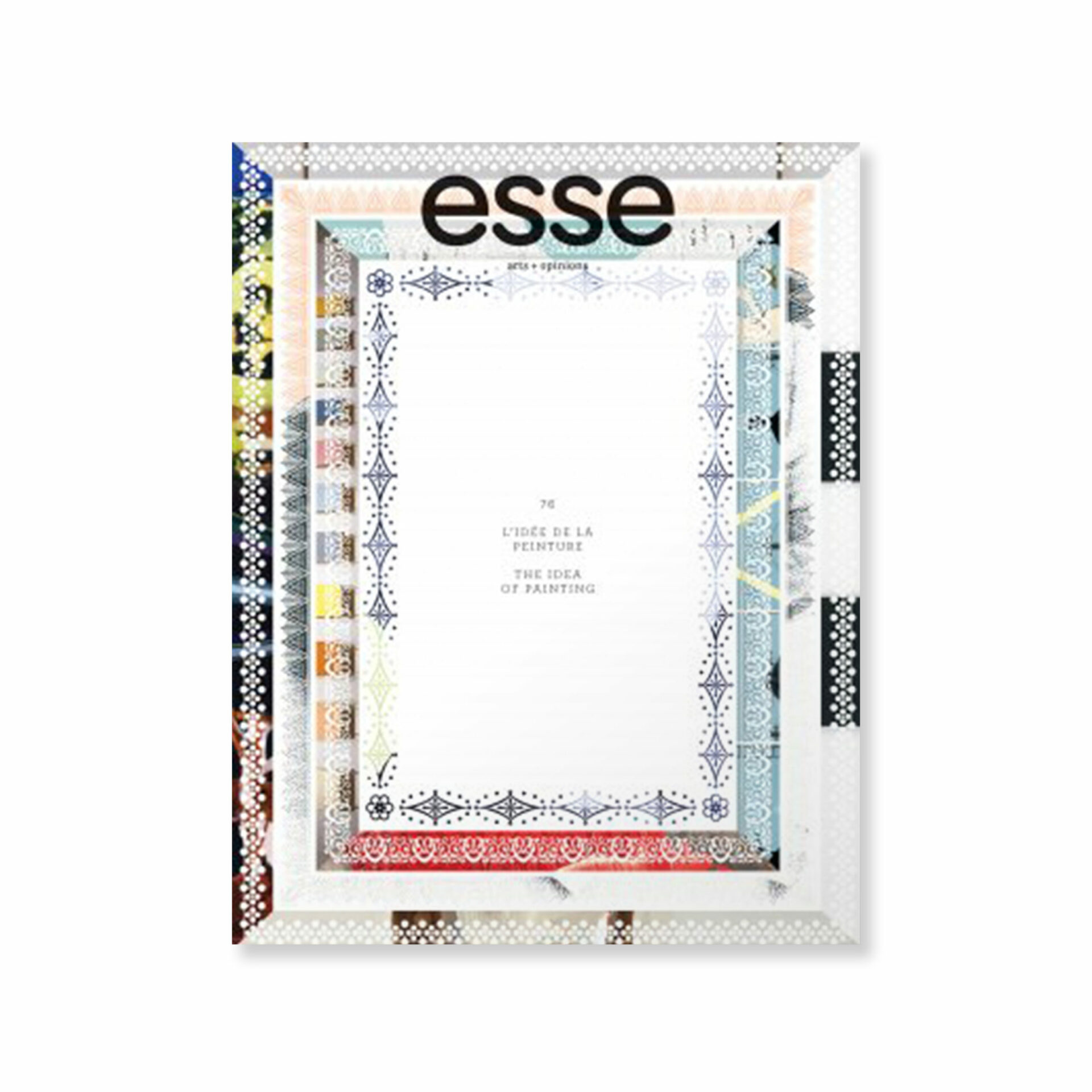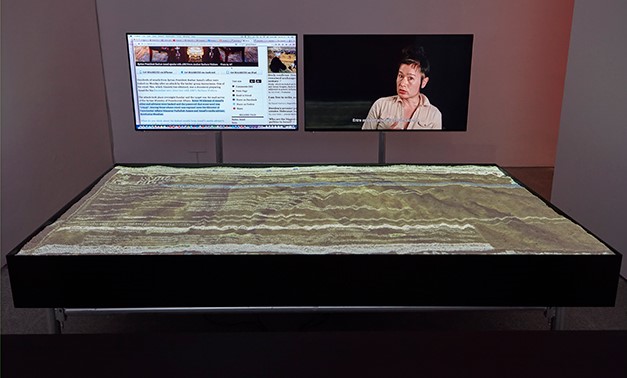
photo : Guy L'Heureux, courtesy of the artist
Artist Marigold Santos interprets the word “haunted” to mean “inhabited or frequented by ghosts; preoccupied, as with an emotion, memory, or idea; obsessed.”1 1 - Marigold Santos, statement on haunted / talisman, accessed January 28, 2012, http://marigoldsantos.com/MARIGOLD_SANTOS/h_t__statement.html. Resident diasporas in Canada, many of which fall under the term “visible minorities,” are often inhabited by ghosts of their past culture and ancestry when physically dislodged or unsettled. However, through Santos’s suggested language, would it not be appropriate to categorize the nation of Canada itself as being haunted? A nation preoccupied with guarding a national identity far more imagined than truthful, Canada clutches to the memory of what Canada ought to be, while neglecting the needs and demands of an ethnically diverse contemporary nation. Artists who question and contradict this haunted national identity — what Benedict Anderson calls an “imagined community,” one that creates and imagines its own nation where a nation does not exist and is “conceived as a deep, horizontal comradeship” despite exploitation and marginalization2 2 - Benedict Anderson, Imagined Communities (London: Verso, 2006), 6 – 7; Ernest Gellner as quoted in Anderson, Imagined Communities, 6. — are often ghettoized by being categorized as creating culturally specific work.
When work is segregated under a blanket term such as “culturally specific,” artists of visible or language minorities are typically encouraged and expected to create work that fits under this designation. (This can happen both intentionally and unintentionally.) How is an artist to provide a voice when consistently categorized as Other, as apart from the Western hegemonic culture? This is the postcolonial dilemma of culturally specific work that many immigrants and ethnically diverse artists attempt to divert (or even tackle directly).
Legislatively, Canada is multicultural;3 3 - The Canadian Multiculturalism Act (1988) states that “every individual is equal before and under the law. . . and has the freedom of conscience, religion, thought, belief, opinion, expression, peaceful assembly and association,” and asserts that “the Constitution of Canada recognizes the importance of preserving and enhancing the multicultural heritage of Canadians.” Jack Jedwab, “Multiculturalism: Definition and Policy and Legislative Framework,” in Canadian Diversity 5, no. 2 (Spring 2006), 3 – 5. however, in practice, multicultural communities must still integrate themselves into the established vision of what Canada essentially is: a nation founded on Western European ideals of modernism, colonialism, and conformity. Postcolonial scholar Igor Maver indicates that in addition to multiculturalism, which many agree to be ineffectual,4 4 - To read more on the limitations of multiculturalism in Canada, see Himani Bannerji, “On the Dark Side of the Nation: Politics of Multiculturalism and the State of ‘Canada,’” in his The Dark Side of the Nation: Essays on Multiculturalism, Nationalism, and Gender (Toronto: Canadian Scholars’ Press, 2000), 87– 124. critical concepts utilized to combat the effects of colonialism include “polyvocality, hybridity, and (post-colonial) mimicry.”5 5 - Igor Maver, “New Diasporic Literature in a Post-ethnic Transcultural Canada,” in Crosstalk: Canadian and Global Imaginaries in Dialogue, eds. Diana Brydon and Marta Dvorák (Waterloo, ON: Wilfred Laurier University Press, March 2012), accessed January 28, 2012, myuminfo.umanitoba.ca/Documents/2142/MaverI.pdf. An artist who immigrated to Canada as a child, Santos attempts to utilize precisely these techniques to counter the expectations of thorough integration while also ultimately planting herself in Canada. By employing hybridity, polyvocality, and mimesis, Santos is able to speak of her ghosts while never fully segregating herself into a culturally specific category. Writing on the hazards of curating from a position within cultural-specificity, which is to say, insubalternity, Alice Jim advocates and investigates working with subalternity6 6 - Alice Ming Wai Jim, ed., “Rearranging Desires: Curating the Other,” in Rearranging Desires, exhibition catalogue (Montréal: Gail and Stephen Jarislowsky Institute for Studies in Canadian Art; Faculty of Fine Arts Gallery, Concordia University, 2008), 2. as a way to “activate resistance against the dominant historiography’s ‘apparatus’ both conceptually and formally.”7 7 - Gayatri Chakravorty Spivak as quoted in Jim, “Rearranging Desires,” 2.

photos : Guy L’Heureux, courtesy of the artist
Indeed, the work of Santos is conceptually and formally tackling issues of subalternity and the grounding (or rooting) of oneself. In Personal Mythologies (2012), an exhibition curated by Zoë Chan displaying the work of Marigold Santos and Osvaldo Ramirez Castillo at Montréal, arts interculturels (MAI), Santos showcases imagery that is deliberately imprecise yet fundamentally accessible, encouraging viewers to make their own associations and interpretations. This work comes from her own remembrances and recollections while accepting and simulating outside translations from said imagery. In the piece Secret Signals 1 (2011), Santos employs hybridity through theoretical and aesthetic means, mixing together folk tales passed down from generation to generation, mysticism, and childhood games. The amalgamation of personal and broader elements in Santos’s work speaks to the universality as well as the particularity that art can offer its viewers — communicating to a vast audience rather than a culturally specific viewership. Santos writes, “In many ways there is some cultural specificity [in my work], however, I am not interested in boundaries that limit the work, and instead prefer to think about hybridities between cultures, ideas, memories, theories [with elements] of ambiguity and open-endedness.”8 8 - Marigold Santos, personal email correspondence with the author, January 29, 2012.
Secret Signals 1 depicts a woman making hand signals with severed limbs. Her right hand is held upside down against her face with the thumb and index finger forming a circle around her eye; her left hand hangs detached from her arm while another severed hand makes the shape of a “C” around her left ear. Underneath her sheer garments is a body made up of different elements: feathers, chains, ropes, bandages, and various textiles. The woman herself is a hybrid of multiple components; components whose references are not culturally specific but, in different ways, relatable and associative for a broad spectrum of the public.
In accepting and corroborating diverse translations of her work, Santos employs polyvocality. Established through the open interpretations of her audience, polyvocality is also, significantly, utilized through the varying influences embedded in her images. There exist multiple perspectives and voices coming through her images, which, in turn, evade the trap of merely representing a stereotyped version of what a culture can represent. In other words, Santos does not “play the Other,” a phrase Olu Oguibe uses to describe the occurrence of culturally specific artists adopting the myths and “corpus of signs” put upon those who show difference.9 9 - Olu Oguibe, “Play me the ‘Other’: Colonialist Determinism and the Postcolonial Predicament,” in The Culture Game (Minneapolis, London: University of Minnesota Press, 2004), 20. Using references or voices, such as folk tales, childhood games, textiles, and natural Canadian anatomy (such as the Canadian Rockies, prairie fields, and weather systems) as well as prompting ambiguous, non-linear, fragmented articulations, Santos’s imagery does not fit within a definite Other.10 10 - Marigold Santos, statement on haunted / talisman, accessed January 28, 2012, http://marigoldsantos.com/MARIGOLD_SANTOS/h_t__statement.html. The hand signals illustrated in Secret Signals 1 come from memories of games Santos played as a child, yet she also states that the silent language “talks about portals being opened, invitations perhaps, and/or conversations with multiple selves.”11 11 - Santos, personal email correspondence with the author. The term “variety” becomes a key designation in discussing Santos’s work: she advocates art from a variety of influences, for a variety of publics, with the hope of instigating a variety of conversations with a variety of selves.

photos : Guy L’Heureux, courtesy of the artist
As illustrated through the surreal quality of Secret Signals 1 — the severed limbs, the visual morphing of the sheer fabric and skin so that one is not sure what is clothing and what is the underlying body — myth is very clearly embedded in the work of Santos. Santos creates her own fictional reality to interpret her physical and inner reality. Yet we must be clear, she does not enact the enforced myth-making described by Oguibe. Discussing the Togolese artist William Wilson, Oguibe writes that “because his difference is more a construct than a truth, he is compelled to invent a myth of Otherness.” Oguibe uses the example of Wilson, an artist who was compelled and expected (by the international art market) to produce culturally specific “African” art, to point to the logical, yet detrimental, strategies used by “post” colonial artists who do not adhere to the Western European prototype.12 12 - Oguibe, “Play me the ‘Other,’” 20.
Santos slyly mimics the mythic quality commonly found in culturally diverse work and shifts away from a constructed myth — one created by others and imposed upon the Other — into a myth that is about her personally: her culture and family, her experience of being uprooted and subsequently grounding herself in her new reality. Just as the title of the exhibition states, Santos’s work is about personal mythologies as she mimics the technique used by the hegemonic power to destabilize and marginalize minorities, thereby creating a mythic identity. This use of mimesis acknowledges the history of Canada and the persistence of discrimination while also taking command in creating Santos’s own identity as opposed to having an identity put upon her. It should be noted that the female figure in Secret Signals 1 does not show evidence of any discernable skin tone: her skin is grey with no recognizably ethnic facial features. This mythological figure is not bound by ethnicity or race: she is visually outside our purview of subalternity.
In Personal Mythologies Santos presents works that are arresting in their surrealist imagery; works that invite the viewer closer, only to strike with notions of displacement, rootedness, and myth-making. In mythologizing her past and present, Santos avoids playing the Other through her use of critical postcolonial tools such as hybridity, polyvocality, and mimicry, and as such, avoids creating ghettoized culturally specific work. Ambiguousness in Santos’s images results in evading outside identification while concurrently addressing social constructs and issues of
marginalization.




